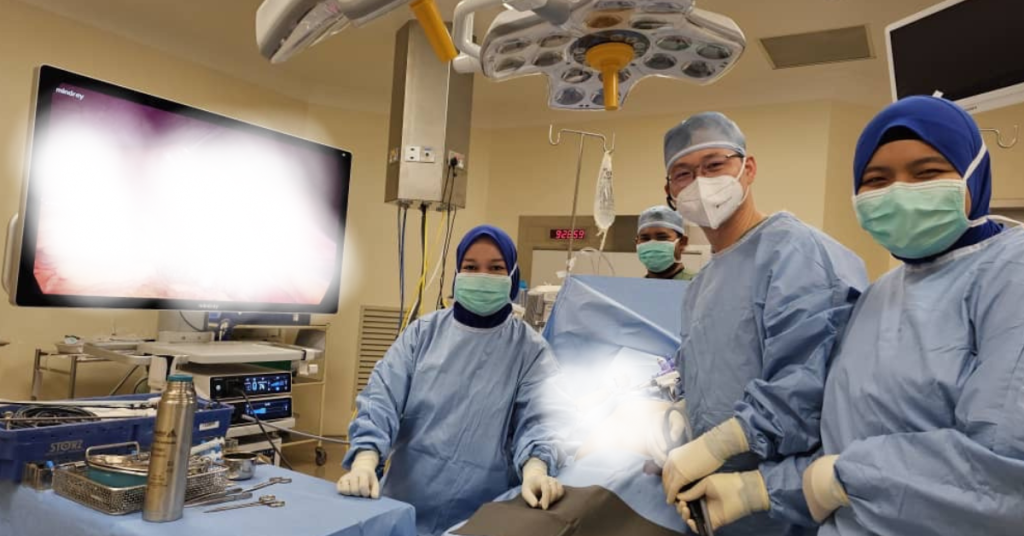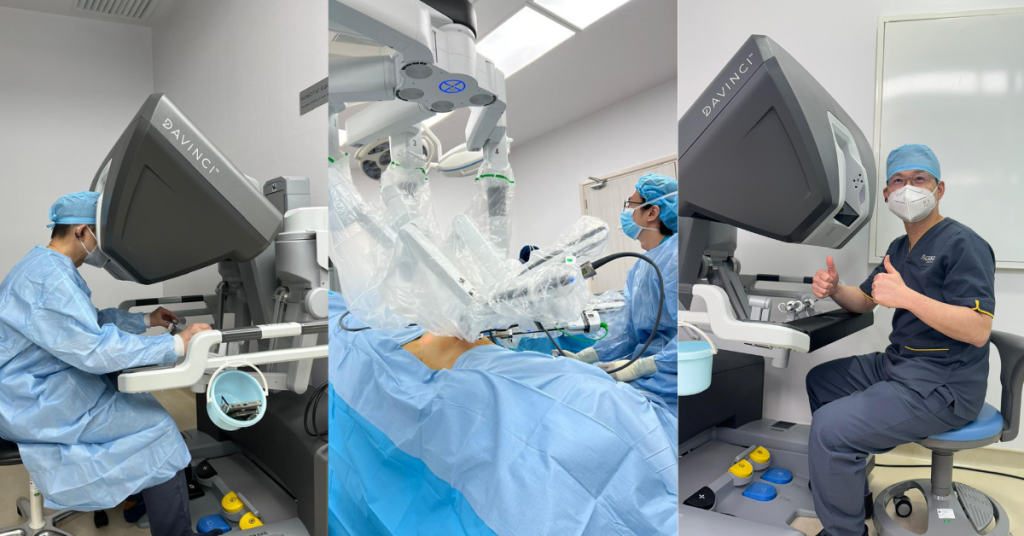“I think I need to go to the hospital.”
Jason turned sharply, startled by his 65-year-old father’s voice. Mr Lee leaned heavily against the kitchen door frame, his face pale and drawn.
“Dad? Are you okay? What happened?”
“I’m not sure… I just feel dizzy. My whole body feels weak… and I have a headache,” Mr. Lee murmured, struggling to stay upright. It was a stark contrast to his usual cheerful, energetic self.
“Alright, let’s go. Now.”
Jason grabbed his keys and helped his father into the car. He drove quickly, pushing through yellow lights, his heart pounding. The only thought racing through his mind was getting his father to the hospital—fast.
Mr. Lee’s blood pressure was recorded at 160/110 mmHg.

A doctor approached them shortly after. “Hi, I’m Dr. Kumar,” he said, addressing Jason. “I know this must be a worrying time for you. We’re doing everything we can to figure out what’s going on. Does your father have a history of high blood pressure?”
“Yes, he does. He’s on medication for it,” Jason replied, voice tight with concern. “Is this… could this be a stroke?”
“We’re checking to rule that out. We’ve sent blood samples to the lab and will run some scans shortly. Just one more thing, does anyone else in the family have high blood pressure, particularly at a young age?”
Jason nodded. “Yes, my uncle. My dad’s brother. He was diagnosed in his mid-thirties. Why? Is that connected to what’s happening?”
“It might be. We’ll keep you updated as soon as we have more information.”
Later, Mr. Lee’s blood work returned, revealing low potassium levels. It’s an unusual finding that caught Dr. Kumar’s attention.
Fortunately, it wasn’t a stroke. The severe headache was linked to his elevated blood pressure, and the dizziness and weakness were likely due to the low potassium.
Mr. Lee was stabilised, but the medical team investigated the underlying cause.
After a thorough series of tests, Mr Lee was finally diagnosed with Conn’s syndrome. It’s a condition that explains both his high blood pressure and low potassium levels.
Conn’s Syndrome: What is It?
This condition occurs when the body produces too much of the hormone aldosterone, leading to high blood pressure and low potassium and renin levels.
Although this disease is extremely rare, it affects about 10-20% of individuals with high blood pressure.
Aldosterone: The Hormone That Balances Salt, Water, and Pressure
This hormone regulates the sodium and potassium levels in your body. It is secreted by the adrenal glands, a pair of organs that sit above the kidneys.
Tiny but mighty: Weighing only 4-5 grams and 5 to 2 cm tall, these triangular-shaped organs secrete aldosterone and other hormones like cortisol, androgens and catecholamines.
These hormones are responsible for regulating stress, developing sexual characteristics of the body, heart rate, metabolic rate and more. Essentially, keeping the body functioning.
What Causes Conn’s Syndrome?
- Adrenal Tumour: Most tumours are benign. Surgery will be sufficient, and the prognosis remains excellent. In the rare event that tumours are found to be malignant/cancerous, an oncologist will come on board to provide advice on other therapies: chemotherapy/radiotherapy.
- Hyperplasia: excessive growth of adrenal tissue and cells, causing overproduction of aldosterone. 60-70% of cases.
- Inherited Condition (rare)
What are the Signs and Symptoms?
- High blood pressure, which does not improve despite taking antihypertensives (resistant hypertension)
- Headaches
- Feeling extremely thirsty
- Urinating often
- Feeling tired and fatigued
- Muscle cramps
- Episodic weakness and at times, paralysis
- Blurry vision

Diagnosing Conn’s Syndrome
A medical team of experts will carry out investigations to confirm the diagnosis.
- Routine Blood Tests
Your doctor may check your electrolytes, aldosterone levels and renin levels in your blood. Renin is a hormone released by your kidneys which regulates blood pressure.
- Imaging
Your doctor may also send you computed tomography (CT) or Magnetic resonance imaging (MRI) scans of your adrenal glands to check for abnormal growths or tumours.
- Specific Testing
Saline Suppression Test (SST)
In this test, you will be asked to consume a high-sodium diet or receive a saline infusion over 4 hours, followed by a blood test to measure aldosterone and other relevant levels.
Captopril Challenge Test (CCT)
For this test, you will take a medication called captopril, which is used to see if it lowers your blood pressure. If you have Conn’s syndrome, your aldosterone levels will stay high, and your renin levels may increase even more, even after taking the medication.
Bilateral Adrenal Vein Catheterisation
This procedure determines whether both adrenal glands are affected by overproduction of aldosterone or if only one is involved. It also helps differentiate between a tumour and hyperplasia (an excessive growth of cells) in the adrenal glands.
You will be closely monitored by a team of specialists to ensure your safety and the accuracy of results.
Robotic and Laparoscopic Adrenalectomy:
If you’re diagnosed with an adrenal tumour, your surgeon may recommend laparoscopic or robotic surgery to remove it.
The benefits:
Minimally invasive techniques, such as laparoscopic and robotic surgery, are now becoming the preferred methods for removing adrenal tumours. Compared to traditional open surgery, these approaches offer several benefits, including:
- Less pain after surgery
- Reduced blood loss
- Shorter hospital stays
- Smaller scars and better cosmetic results
These advancements mean a quicker recovery and a more comfortable experience for patients overall.

Preparing for Surgery
Before your surgery, you’ll undergo some routine blood tests, including a blood crossmatch, just in case a transfusion is needed during the procedure.
Your medical team will also do a thorough pre-surgical assessment to make sure you’re fit for surgery. This includes checking for any existing health conditions (comorbidities) that may need special attention.
Be sure to inform your doctors about all the medications you’re taking—including over-the-counter ones and supplements. You may be asked to pause certain medications before surgery, especially if they affect bleeding or blood pressure.
Finally, you’ll need to fast for at least 6 hours before your surgery. This means no food or drinks (including water) during that time to ensure your safety while under anaesthesia.
What Happens During?
The procedure typically takes 2 to 3 hours, and you’ll be placed under general anaesthesia, which means you’ll be asleep and pain-free throughout the surgery. You’ll also be given pain relief and sedatives to keep you comfortable before and after the operation.
Laparoscopic Surgery
During the procedure, your surgeon will make 3 to 4 small incisions in your abdomen. Through these tiny openings, a camera and special surgical instruments are inserted carefully to remove the affected adrenal gland.
To allow the surgeon more room to work, your abdomen will be gently inflated with carbon dioxide gas. This creates space and improves visibility inside your body.
Fret not, the gas is released at the end of the surgery, and your tummy will return to normal.
Robotic Surgery
In robotic-assisted surgery, such as with the da Vinci Surgical System, the surgeon doesn’t stand over the operating table. Instead, they sit at a console just a few feet away, using hand controls to guide robotic instruments with incredible precision.
This advanced technology allows surgeons to operate with greater flexibility, control, and accuracy. The system also provides a high-definition, 3D view of the adrenal glands and tumour, helping the surgical team see fine details more clearly than ever before.
Thanks to this cutting-edge approach, robotic-assisted surgery can make complex procedures safer and more effective.

What Happens After?
In most cases, after the adrenal gland is removed, your aldosterone and potassium levels return to normal, and your blood pressure may also improve, sometimes even returning to a healthy range.
After the operation, it’s normal to experience some post-operative pain, but you’ll be given pain relief to keep you comfortable. Some people may also feel nauseous, which is a common side effect of general anaesthesia and usually settles within a day.
If everything goes smoothly and there are no complications, you should be able to go home as early as the next day.Your medical team will advise you on what to eat, how to care for your wounds, and what activities you should avoid or ease back into. Follow-up appointments will also be arranged to check on your recovery, monitor your blood pressure, and support your return to daily life.
What are the Risks to look out for?
Like any surgery, there are some risks to be aware of, although they are generally rare:
- Bleeding: While bleeding is usually minimal (less than 100cc), in very rare cases, a blood transfusion may be needed.
- Infection: To reduce the risk of infection, you’ll be given antibiotics before the surgery.
- Conversion to open surgery: In some cases, if the tumour or adrenal gland is difficult to remove, or if the situation is more complicated than expected, your surgeon may decide to switch to a traditional open surgery.
- Injury to nearby organs or nerves: While extremely rare, there is a small risk of injury to nearby organs like the bowel, kidneys, gallbladder, or pancreas.
Your medical team takes every precaution to minimise these risks and ensure your safety during surgery.
What is the success rate?
Most patients recover uneventfully and resume day-to-day activities relatively fast.
If You Are Not Eligible For Surgery
Medications such as spironolactone or eplerenone, which block the effects of aldosterone, are commonly prescribed to help lower blood pressure and correct potassium levels.
Your doctor may also prescribe additional antihypertensive medications for your high blood pressure.
Should I Get Checked?
Your doctor may recommend that you get checked for Conn’s syndrome if
- You still have high blood pressure despite being on 3 different types of antihypertensives
- You have high blood pressure and low potassium levels in your blood
- You have high blood pressure and sleep apnea
- You have high blood pressure and a family member diagnosed with Conn’s syndrome.
- You have high blood pressure and family members who were diagnosed with high blood pressure or stroke before the age of 40.
Can it be prevented?
Unfortunately, there is no cure for Conn’s Syndrome.
If you or a loved one has symptoms of Conn’s Syndrome, seek advice from a healthcare professional today.
References
- Anatomy, Abdomen and Pelvis: Adrenal Glands (Suprarenal Glands) https://www.ncbi.nlm.nih.gov/books/NBK482264/#:~:text=The%20paired%20adrenal%20glands%20are,The%20Urinary%20Organs). [Last accessed 8 April 2025]
- Primary Aldosteronism (Conn’s Syndrome) https://my.clevelandclinic.org/health/diseases/21061-conns-syndrome [Last accessed 7 April 2025]
- DASH diet: Healthy eating to lower your blood pressure https://www.mayoclinic.org/healthy-lifestyle/nutrition-and-healthy-eating/in-depth/dash-diet/art-20048456 [Last accessed 7 April 2025]
- Exercise: 7 benefits of regular physical activity https://www.mayoclinic.org/healthy-lifestyle/fitness/in-depth/exercise/art-20048389 [Last accessed 7 April 2025]
- Primary Aldosteronism https://www.hopkinsmedicine.org/health/conditions-and-diseases/primary-aldosteronism [Last accessed 7 April 2025]
- The Prevalence of Primary Aldosteronism and Evolving Approaches for Treatment https://pmc.ncbi.nlm.nih.gov/articles/PMC7442120/ [Last accessed 7 April 2025]
- Conn Syndrome https://www.ncbi.nlm.nih.gov/books/NBK459197/ [Last accessed 7 April 2025]
- Adrenalectomy https://www.hopkinsmedicine.org/health/treatment-tests-and-therapies/adrenalectomy#:~:text=Laparoscopic%20Adrenalectomy&text=The%20surgery%20is%20performed%20through,remove%20the%20diseased%20adrenal%20gland. [Last accessed 9 April 2025]